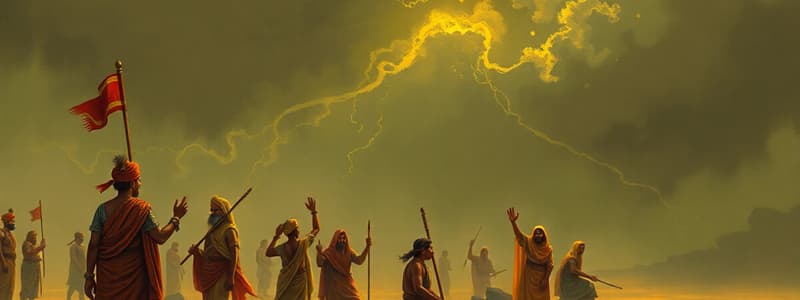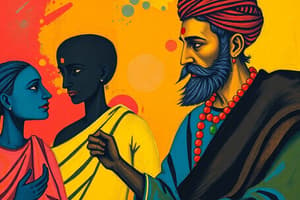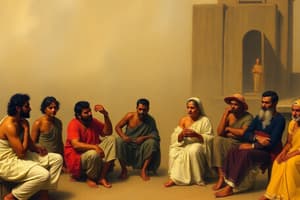Podcast
Questions and Answers
What motivated Periyar Ramasami to start the Self-respect Movement?
What motivated Periyar Ramasami to start the Self-respect Movement?
Periyar Ramasami was motivated by the belief that equality for all could only be achieved through the eradication of the caste system.
Describe the significance of the Hitakarini Samajam founded by Periyar.
Describe the significance of the Hitakarini Samajam founded by Periyar.
The Hitakarini Samajam was significant as it focused on social reforms and the upliftment of marginalized groups, especially concerning women's rights.
How did Gandhi's actions reflect his views on untouchability?
How did Gandhi's actions reflect his views on untouchability?
Gandhi's actions, such as eating with people of all castes and washing toilets in his ashram, reflected his belief that untouchability was unjust and that all people should be treated equally.
What role did education play in the reforms advocated by figures like Periyar and Gandhi?
What role did education play in the reforms advocated by figures like Periyar and Gandhi?
What actions did Dr. Babasaheb Ambedkar take to fight for Dalit rights?
What actions did Dr. Babasaheb Ambedkar take to fight for Dalit rights?
What was the impact of the caste system on Indian society as discussed in the context of social reformers?
What was the impact of the caste system on Indian society as discussed in the context of social reformers?
In what ways did Mahatma Phule contribute to the movement against caste discrimination?
In what ways did Mahatma Phule contribute to the movement against caste discrimination?
How did the government respond to Periyar's agitations regarding the rights of the oppressed?
How did the government respond to Periyar's agitations regarding the rights of the oppressed?
How did caste divisions affect individual progress in society?
How did caste divisions affect individual progress in society?
What role did thinkers like Mahavira and Buddha play in opposing the caste system?
What role did thinkers like Mahavira and Buddha play in opposing the caste system?
What was the significance of Jotirao Phule's work in the 19th century?
What was the significance of Jotirao Phule's work in the 19th century?
Describe Sree Narayana Guru's contributions to the fight against caste discrimination.
Describe Sree Narayana Guru's contributions to the fight against caste discrimination.
What was Kandukuri Veeresalingam's stance on caste distinctions and women's rights?
What was Kandukuri Veeresalingam's stance on caste distinctions and women's rights?
In what ways did the 19th-century social reformers view the caste system?
In what ways did the 19th-century social reformers view the caste system?
What was the main aim of the reformers in the 19th and early 20th centuries regarding the caste system?
What was the main aim of the reformers in the 19th and early 20th centuries regarding the caste system?
How did education play a vital role in the reform movements led by figures like Sree Narayana Guru?
How did education play a vital role in the reform movements led by figures like Sree Narayana Guru?
How did the adoption of Buddhist faith by social reformers like Dr. B.R. Ambedkar contribute to societal changes?
How did the adoption of Buddhist faith by social reformers like Dr. B.R. Ambedkar contribute to societal changes?
What message did Jotirao Phule convey about religious beliefs and superstitions?
What message did Jotirao Phule convey about religious beliefs and superstitions?
What legislative changes were influenced by the reform movements in India?
What legislative changes were influenced by the reform movements in India?
Explain the role of education in improving the lives of Dalits and OBCs in independent India.
Explain the role of education in improving the lives of Dalits and OBCs in independent India.
What was the significance of including Dalits and tribal people in the Ninth Schedule of the Indian Constitution?
What was the significance of including Dalits and tribal people in the Ninth Schedule of the Indian Constitution?
Identify one prominent figure from the Dalit community who achieved a significant political position in India.
Identify one prominent figure from the Dalit community who achieved a significant political position in India.
What impact did the reform movements have on feelings of nationalism among Indians?
What impact did the reform movements have on feelings of nationalism among Indians?
Discuss the constitutional measures taken to prevent discrimination against scheduled castes and tribes.
Discuss the constitutional measures taken to prevent discrimination against scheduled castes and tribes.
Flashcards are hidden until you start studying
Study Notes
The Caste System in India
- The caste system hindered individual progress and discouraged societal advancement.
- Lack of unity amongst castes hampered national defense against external threats.
- Inherited status, through birth, prohibited individuals from 'lower' castes from pursuing occupations reserved for 'privileged' castes leading to widespread incompetence and social decline.
History of Reform Movements
- Mahavira and Buddha (6th century BCE) challenged the injustices of the caste system.
- Bhakti Saints (8th century CE) asserted the equality of all humans, contradicting the caste system's religious justification.
- 19th Century Social Reformers like Keshab Chandra Sen and Mahatma Jotirao Phule condemned the caste system.
- Mahatma Jotirao Phule (1827-1890):
- Worked relentlessly to uplift the lower castes.
- Founded the Satya Shodhak Samaj (1873) in Maharashtra to advocate for the upliftment of Dalits and women.
- Criticized the superstitious beliefs used by the 'privileged' castes to oppress the 'lower' castes.
- Advocated for equality in the eyes of God.
- Sree Narayana Guru (1856-1928):
- Fought against the caste system's evils in Kerala.
- Established the Sree Narayana Dharma Paripalana Yogam (SNDP) in 1903 to reform society.
- Opened the Aruvipuram temple to all castes.
- Emphasized the importance of education for the upliftment of Dalits.
- Founded various educational institutions for the oppressed classes.
- Kandukuri Veeresalingam (1848-1919):
- Advocated for the Brahmo Samaj in Andhra Pradesh.
- Opposed caste distinctions and meaningless customs.
- Fought for women's rights and against untouchability.
- Founded the Hitakarini Samajam in 1906 for societal reform.
- Started a school for girls in Dowlaiswaram and promoted widow remarriages.
- Periyar Ramasami (1879-1973):
- Championed the cause of the downtrodden in Tamil Nadu.
- Strongly opposed atrocities against Dalits.
- Advocated for equal opportunities for all genders.
- Criticized the superiority of the priestly class and other privileged classes.
- Founded the Self-Respect Movement and led the Justice Party, which he transformed into the Dravidar Kazhagam.
- Believed the eradication of the caste system was necessary for true equality.
- His activism led to constitutional amendments protecting the rights of the oppressed and the introduction of reservation for these classes.
Mahatma Gandhi (1869-1948)
- Recognized the connection between the caste system and India's true freedom.
- Fought for the inclusion of Dalits in temples.
- Established the Anti-Untouchability League.
- Promoted equality through personal example in his ashram, where people from all castes ate together and he performed menial tasks, demonstrating that such work did not make individuals ‘untouchable.’
Dr Babasaheb Bhimrao Ambedkar (1891-1956)
- The architect of the Indian Constitution.
- A prominent scholar who faced humiliation due to his identity as a Dalit.
- Dedicated his life to fighting for Dalit rights and dignified living.
- Advocated for Dalit access to temples and public wells.
- Urged Dalits to reject religious taboos and superstitions that perpetuated their servitude.
- Converted to Buddhism, which he believed promoted a classless society.
The Impact of Reform Movements
- 19th and early 20th century reformers awakened the Indian population.
- Their efforts led to British legislation against Sati and Child Marriage.
- Increased awareness of the caste system's injustice fostered a sense of equality and contributed to the rise of nationalism.
- The Indian Constitution guaranteed equality and outlawed discrimination, including untouchability.
- Affirmative action was implemented to counter past discrimination and ensure equal opportunities for marginalized groups.
- Dalits and tribal people were categorized as Scheduled Castes and Scheduled Tribes, with reserved quotas in government and educational institutions to achieve equal representation.
- The Indian government also recognized Other Backward Classes (OBCs) and implemented reservations for them.
- Despite slow progress, there has been improvement in the lives of Dalits and OBCs.
- Many individuals from Dalit communities have achieved prominent positions in independent India, including presidents and chief ministers.
Studying That Suits You
Use AI to generate personalized quizzes and flashcards to suit your learning preferences.




